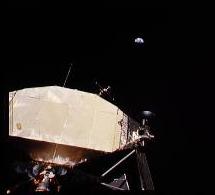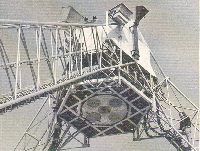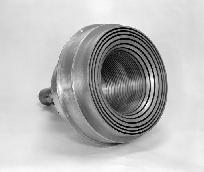On Eagle's Wings: The Story of the Parkes Apollo 11 Support
The Unified S-band Communication System

Photo NASA: The Steerable S-Band antenna on Eagle pointing at the Earth. |
The LM spacecraft telemetry operated at S-band with a carrier frequency of 2282.5 MHz. The S-band steerable antenna, located at the top of the LM ascent stage, was used to transmit the television signals and other telemetry. Communications from the LM were limited by the available power and bandwidth. Consequently, the full spectrum of the signal contained both the telemetry and the TV; a separate commercial-standard TV telecast was not possible. The TV was frequency modulated (FM) on the carrier, and the subcarriers, which were phase modulated (PM) at several different frequencies, contained the telemetry information. They were:-
Information Freq. or Rate RF Carrier Subcarrier Subcarrier
Modulation Mudulation Frequency
LM Telemetry High bit rate: 51.2 PM Phase Shift 1.024 MHz
(Pulse-code-mod. Low bit rate: 1.6
non return zero)
Voice 300-3000 Hz PM FM 1.25 MHz
Biomedical 14.5 KHz subcarrier PM FM 1.25 MHz
(pulse rate,
space suit
consumables etc.)
Television 10 Hz - 500 KHz FM baseband
This was collectively referred to as the Unified S-Band Communication System (USB) (Kelly 1969).

Photo CSIRO: Under-side view of the Focus Cabin showing the feed positions. |
Parkes had two receivers installed in the focus cabin of the telescope (an excellent example of NASA's policy of building system redundancy, which later proved to be fortuitous). One receiver was placed at the focus of the telescope, and the other was offset a small distance, in one of the four off-axis positions. The receivers were supplied by JPL, and were commercial units built by the US company Micromega. They had room temperature parametric amplifiers and system temperatures of less than 100 K (most probably Tsys of 80 K).

Photo CSIRO: The CSIRO designed Apollo feed horn. |
Dr Bruce Thomas of the CSIRO Radiophysics Division designed the feed horns for the receivers. The horn for the main (on-axis) receiver was a one wavelength, two hybrid-mode corrugated horn. The horn for the off-axis receiver had a smooth circular cross-section with a flared tapered aperture, and a corrugation surrounding the aperture of the horn. The main receiver horn was the first experimental test bed corrugated horn which was used to verify the operation of a two hybrid-mode horn. This innovative CSIRO-designed feed horn increased the sensitivity and bandwidth of the receivers. It was originally designed to operate at 2700 MHz, which was a routine operating frequency in those days. Bruce was able to change the tapered section to operate at the lower frequency of 2282.5 MHz. The corrugated section remained unchanged.
NASA calculated the relative velocity of the spacecraft, and the amount the carrier frequency was Doppler shifted was determined. These frequency predicts were then used to tune the receivers (by altering the LO frequencies) in order that the down-converted carrier be centred in the bandpass of the 50 MHz IF. These frequency predicts were supplied by NASA on teletype machines, just hours before the tracks commenced.
Next
Comments to: John Sarkissian



